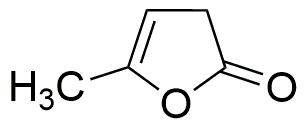a-Angelicalactone is widely utilized in research focused on:
- Flavor and Fragrance Industry: This compound is valued for its pleasant aroma and is commonly used in perfumes and food flavorings, enhancing sensory experiences in products.
- Pharmaceuticals: It has potential applications in drug formulation, particularly in developing anti-inflammatory and antimicrobial agents, providing a natural alternative to synthetic compounds.
- Aromatherapy: Known for its calming properties, a-Angelicalactone is used in essential oils, promoting relaxation and stress relief, which is beneficial in wellness practices.
- Cosmetics: Its skin-conditioning properties make it a popular ingredient in skincare products, helping to improve skin texture and hydration.
- Research in Natural Products: As a naturally occurring compound, it serves as a model for studying the chemistry of plant-derived substances, aiding in the discovery of new bioactive compounds.
General Information
Properties
Safety and Regulations
Applications
a-Angelicalactone is widely utilized in research focused on:
- Flavor and Fragrance Industry: This compound is valued for its pleasant aroma and is commonly used in perfumes and food flavorings, enhancing sensory experiences in products.
- Pharmaceuticals: It has potential applications in drug formulation, particularly in developing anti-inflammatory and antimicrobial agents, providing a natural alternative to synthetic compounds.
- Aromatherapy: Known for its calming properties, a-Angelicalactone is used in essential oils, promoting relaxation and stress relief, which is beneficial in wellness practices.
- Cosmetics: Its skin-conditioning properties make it a popular ingredient in skincare products, helping to improve skin texture and hydration.
- Research in Natural Products: As a naturally occurring compound, it serves as a model for studying the chemistry of plant-derived substances, aiding in the discovery of new bioactive compounds.
Documents
Safety Data Sheets (SDS)
The SDS provides comprehensive safety information on handling, storage, and disposal of the product.
Product Specification (PS)
The PS provides a comprehensive breakdown of the product’s properties, including chemical composition, physical state, purity, and storage requirements. It also details acceptable quality ranges and the product's intended applications.
Certificates of Analysis (COA)
Search for Certificates of Analysis (COA) by entering the products Lot Number. Lot and Batch Numbers can be found on a product’s label following the words ‘Lot’ or ‘Batch’.
*Catalog Number
*Lot Number
Certificates Of Origin (COO)
This COO confirms the country where the product was manufactured, and also details the materials and components used in it and whether it is derived from natural, synthetic, or other specific sources. This certificate may be required for customs, trade, and regulatory compliance.
*Catalog Number
*Lot Number
Safety Data Sheets (SDS)
The SDS provides comprehensive safety information on handling, storage, and disposal of the product.
DownloadProduct Specification (PS)
The PS provides a comprehensive breakdown of the product’s properties, including chemical composition, physical state, purity, and storage requirements. It also details acceptable quality ranges and the product's intended applications.
DownloadCertificates of Analysis (COA)
Search for Certificates of Analysis (COA) by entering the products Lot Number. Lot and Batch Numbers can be found on a product’s label following the words ‘Lot’ or ‘Batch’.
*Catalog Number
*Lot Number
Certificates Of Origin (COO)
This COO confirms the country where the product was manufactured, and also details the materials and components used in it and whether it is derived from natural, synthetic, or other specific sources. This certificate may be required for customs, trade, and regulatory compliance.

